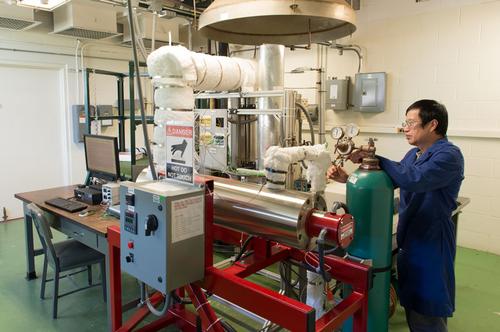DoE Creates Thermal Storage System for Nighttime Solar Use
The Department of Energy has developed a new thermal-energy storage system for solar energy so it can be used at night.
September 28, 2016
Researchers are eyeing different methods for the storage of solar energy for use at night and when sunshine is less plentiful. We told you recently how a team at Eindhoven University of Technology is using a combination of food waste and carbon nanotubes as the basis of an alternative-energy storage system. The Department of Energy (DoE) also is working on the problem, having recently developed a new thermal-energy storage system that researchers said can perform 20 times better than similar systems.
A team at the DoE’s Argonne National Laboratory is building a pilot-scale prototype of a high-efficiency latent heat thermal energy storage system thanks to funding from the DoE’s SunShot Initiative. SunShot funds projects designed to accelerate the market competitiveness of solar power; it also provided support for a recent DoE effort to accelerate the development of modules and materials to drive down the cost of solar energy.

Argonne National Laboratory mechanical engineer Wenhua Yu prepares to test a prototype thermal energy storage system developed at Argonne that will charge and discharge 20 times faster than current high-efficiency latent heat thermal energy storage systems. (Source: Argonne National Laboratory/Department of Energy)
Argonne’s thermal energy storage system depends on what’s called a “phase-change” material, which melts as it stores thermal energy and then releases energy when it refreezes. This process is similar to how a battery charges and discharges.
The problem with creating phase-change-based storage systems historically has been that while the materials that can be used as phase-change materials -- ie, salts like rock salt, or sodium chloride -- are inexpensive, they are limited in ability to perform well because they lack good thermal conductivity.
Researchers at Argonne solved this problem by integrating the salts with a high-conductivity graphite foam to improve their conductivity dramatically, said Dileep Singh, leader of Argonne’s Thermal-Mechanical Technologies group.
“Phase-change materials tend to have low conductivity but meet the heat energy-storage requirements,” he said. “High-conductivity graphite foam meets the conductivity requirements, so we thought: why not combine the two?”
Another benefit of combining the two also reduces the overall amount of material that the system needs -- thus reducing its cost -- while providing up to eight to 12 hours of energy storage by making the thermal energy transfer significantly more efficient, researchers said. This is a typical night of storage for solar energy in a solar power plant.
How the materials work together is that the porous graphite foam traps the salts in pores, which allows for rapid melting and freezing, according to researchers. They already have demonstrated that this rapid phase change is sustainable over time by building and testing a prototype of the system that’s the size of a blender. They are now working to scale up this prototype size by 50 times in a modular, full-scale power-plant system, said Argonne mechanical engineer Wenhua Yu.
READ MORE ARTICLES ON SOLAR ENERGY STORAGE:
“The pilot-scale system we are building this year can actually be used as one module within a full-scale system that is made of many modules stacked or organized together,” he said. “Therefore, the performance characteristics we will measure from testing the pilot can directly reflect those of a power-plant system.”
Researchers expect that the full-scale design will meet the needs of current power plants that operate steam turbines at about 850F to 1,100F using magnesium chloride as the storage medium, researchers said. The design also should scale up using sodium chloride when advanced super-critical carbon dioxide turbines -- which are more efficient but operate at a hotter 1,300F -- come into use, they said.
Elizabeth Montalbano is a freelance writer who has written about technology and culture for more than 15 years. She has lived and worked as a professional journalist in Phoenix, San Francisco, and New York City. In her free time she enjoys surfing, traveling, music, yoga, and cooking. She currently resides in a village on the southwest coast of Portugal.
About the Author(s)
You May Also Like



